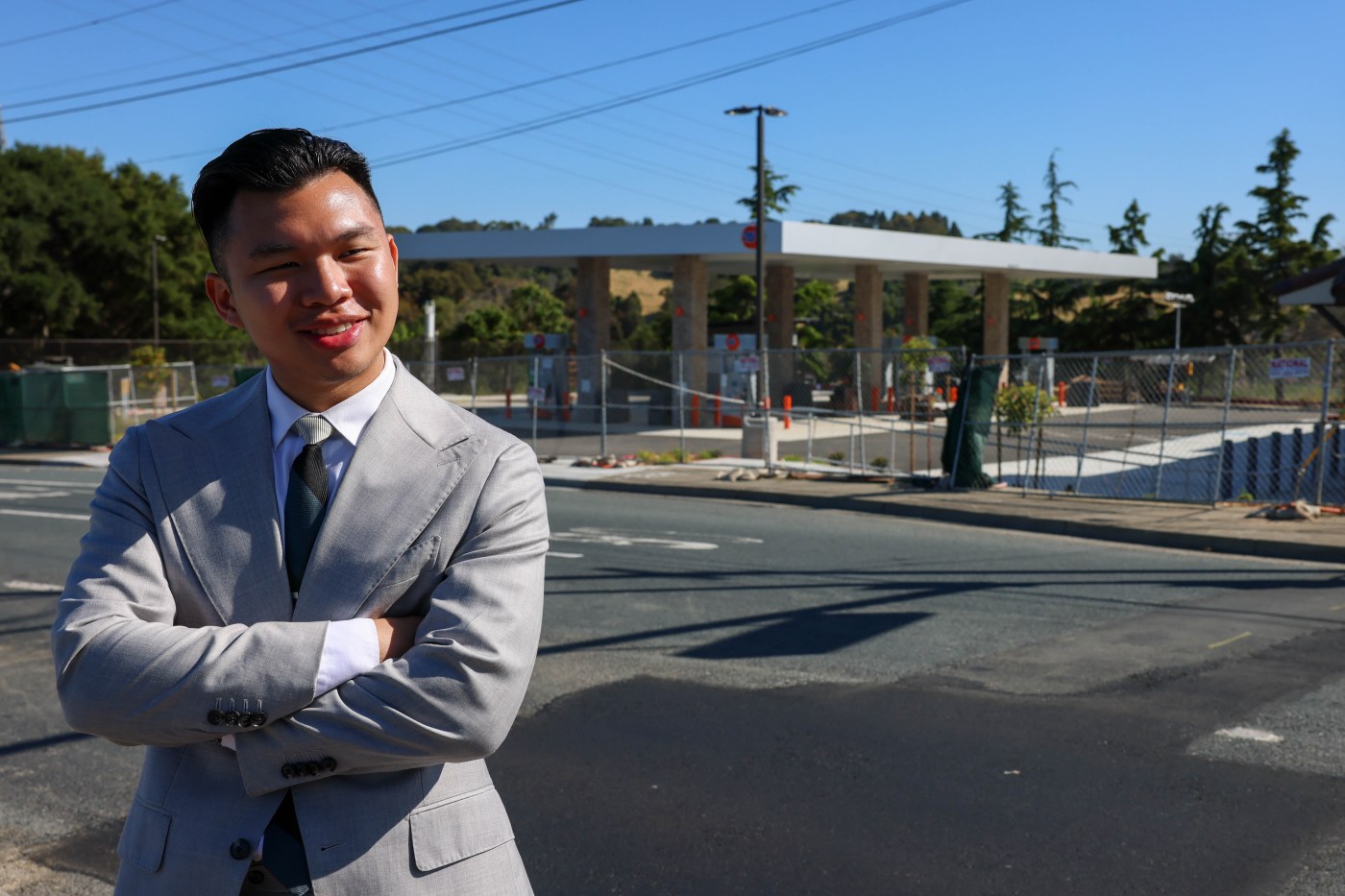When Pinole made news last month for being the first East Bay city to ban new gas stations, the small community of 18,000 was tapping into a trend that has been spreading through the Bay Area for the last three years.
It all started when Petaluma became the first city in the country to ban new gas stations in 2021. But the activists who originally launched that first effort had no idea it would turn into a movement — in fact, JoAnn McEachin, a Petaluma resident who helped start the group NoGasHere a decade ago, says she had no intention of becoming an activist at the time, and she wasn’t even opposed to new gas stations in general.
Her issue was with a 16-pump gas station that had been proposed by the supermarket chain Safeway in 2013. Petaluma, a North Bay city of 60,000 residents, already had 16 gas stations, but her specific issue was with its location — the grocer was looking to build on the corner of McDowell Boulevard and Maria Drive, just across the street from a campus that housed an elementary school, a child development center and a preschool.
McEachin believed being upwind from the roughly 2,000 vehicles it was estimated would drive in and out of the station per day would put the children at risk of poor air quality. She connected with a group of other concerned residents — many of them local moms — who rallied together to form NoGasHere, bringing skills from their day jobs as lawyers, marketing professionals, teachers and administrative assistants to their cause.
“(Safeway) pissed off a lot of women,” said McEachin. “It makes my blood boil when I think about it.”
Despite their efforts, the group failed to stop the gas station plan from moving forward after a crucial 2018 City Council vote. Former Petaluma Councilmember D’Lynda Fischer said the council’s hands were tied — Safeway’s proposal had adhered to all necessary laws for approval.
“Although many of us didn’t want to vote for the gas station, and agreed it shouldn’t go there, there was nothing about our laws that said they couldn’t,” Fischer said.
The fight didn’t stop, though. A small group of NoGasHere members, renamed Save Petaluma, appealed the council’s decision, taking Safeway and the city to court to force the company to conduct a more expansive environmental review. After a tough two-year legal battle, Save Petaluma won and Safeway pulled its plans. The site is now being developed into a health care facility.
In 2021, Petaluma’s City Council declared a climate emergency and changed its zoning laws to prohibit the creation of new gas stations.
Fischer, who played a leading role in both of those policy proposals, said she was grateful Save Petaluma filed its appeal. For McEachin and her group, the win was a terrific feeling.
“I’m super happy we were able to fight back, and it enabled others to say, ‘Hey wait, we’ve got to do that, too,’” McEachin said.
Other Sonoma County communities took notice, starting with the tiny city of Cotati, where Jenny Blaker and Woody Hastings were fighting multiple gas station proposals in the rural part of the county. Besides emissions from vehicles, they were also concerned about toxic leakage from underground fuel tanks, which can poison local soil and groundwater. The Environmental Protection Agency reports that there are currently about 58,000 contaminated sites nationwide from such leakage. In 2022, Safeway agreed to pay $8 million after the state attorney general’s office accused the company of breaking gasoline-leak prevention laws at its 71 California gas stations, including 18 in the Bay Area.
Blaker and Hastings’ group Coalition Opposing New Gas Stations, or CONGAS, defeated one proposal but quickly learned of three others. Recognizing the tedious work that would be required to halt individual gas station development proposals, they instead began pushing for land use changes, using Petaluma’s ordinance as a model.
“We had a sense of urgency because it seemed to us at the time that, ‘Gee, there’s a lot of new gas station proposals. We have to stop this,’” Hastings said.
The movement spread through Sonoma County, with similar restrictions eventually covering Rohnert Park, Sebastopol, Cotati, Novato, Windsor, unincorporated areas and the county’s largest city, Santa Rosa.
Cloverdale, Healdsburg and Sonoma are the last three cities in Sonoma County without similar gas bans in place. Cloverdale leaders considered adopting a ban in 2022 but voted to table the issue.
Meanwhile, cities in Napa County also followed Petaluma’s lead. In January, St. Helena joined Calistoga, Yountville, American Canyon and Napa — which has a temporary ban — in making Napa County the first in the country to have a prohibition on new gas stations in all of its municipalities. Marin County’s Fairfax and San Anselmo have also approved similar measures.
Opponents of the gas-ban policies — like the California Fuels and Convenience Alliance, an organization representing 300 gas station companies and haulers in California — assert the bans could cause price spikes; that they disproportionately harm small, minority-owned businesses; and that they ignore the benefits of tax revenue generated from the industry.
“Beyond risking significant job loss and impacting small businesses, especially those largely owned by minorities and immigrants, a ban neglects the intricate economic interconnections within California,” read a letter from the group published in January in response to Sacramento adding a new gas station ban policy to its 2040 General Plan.
Related Articles
3.5 million acres of Mojave Desert where military trains designated California’s first Sentinel Landscape
Trees, not asphalt: The $1 billion effort to build ‘cooler’ California school playgrounds
Capitola Wharf, wrecked in huge winter storms, set to reopen after $10 million upgrade
That mouth-watering aroma of fresh food cooking? It may be degrading air quality
NASA researchers bid farewell to ‘flying laboratory’ at Ames Research Center
Pinole’s ban, part of the city’s effort to reduce its greenhouse gas emissions to at least 40 percent below 1990 levels by 2030, is the movement’s first victory in the East Bay. It is technically a temporary moratorium but is likely to be extended when staff comes back with language for a permanent policy. Zoning already limits service stations to the western part of the city, but the moratorium extends that limitation across city boundaries and also limits the expansion of existing stations.
Pinole Mayor Pro Tem Cameron Sasai, who worked on the policy in partnership with Councilmember Devin Murphy, said Petaluma was definitely a model for Pinole’s ban.
“Seeing what Petaluma did, the gas station ban, to me, was an obvious next step for our community to end our reliance on fossil fuels,” Sasai said. “l’m proud that our city is leading the way in the East Bay.”
Cotati’s Hastings — an energy and environmental policy analyst, strategic planner, and community organizer of more than 30 years who currently works with statewide nonprofit The Climate Center — said gas stations, while an essential business for millions of drivers now, are already plentiful in most communities, and will eventually become obsolete.
He said the steady spread of gas station bans across the Bay Area is proof that a grassroots political movement can still be built, sustained and grown in an uncertain landscape of national politics.
“A lot of times, it’s the powerful entrenched forces that have the resources to crush whatever efforts we might make to get something done,” Hastings said. “It’s important to remember sometimes we win.”












